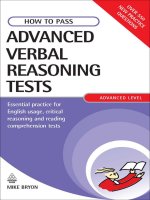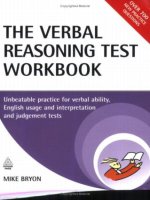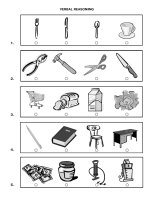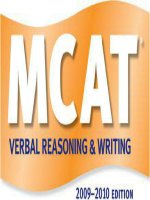Kaplan MCAT verbal reasoning writing
Bạn đang xem bản rút gọn của tài liệu. Xem và tải ngay bản đầy đủ của tài liệu tại đây (1.3 MB, 239 trang )
The Staff of Kaplan
Contents
How to Use this Book
Introduction to the MCAT
Part I: Verbal Reasoning
Chapter 1: Introduction to Verbal Reasoning
Chapter 2: Reading the Kaplan Way
Chapter 3: Keywords
Chapter 4: The Verbal Reasoning Question Types
Part II: The Essay
Chapter 5: Introduction to the Essay
Chapter 6: Building Your Essay
Chapter 7: Usage and Style
Part III: Verbal Reasoning and Essay Practice Sections
Verbal Reasoning Practice Section 1
Verbal Reasoning Practice Section 2
Verbal Reasoning Practice Section 3
Essay Practice Section
Answers and Explanations
How to Use this Book
Kaplan Verbal Reasoning and Writing , along with the other five books in our MCAT subject review series, brings the Kaplan
classroom experience right into your home!
Kaplan has been preparing premeds for the MCAT for more than 40 years in our comprehensive courses. In the past 15 years
alone, we've helped over 400,000 students prepare for this important exam and improve their chances of medical school admission.
Think of Kaplan's five MCAT subject books as having a private Kaplan teacher right by your side! We've created a team of the
top MCAT teachers in the country, who have read through these comprehensive guides. In the sidebars of every page, they offer the
same tips, advice, and test day insight that they offer in their Kaplan classroom.
Pay close attention to Teacher Tip sidebars like this:
TEACHER TIP
Did you know that many medical schools consider your MCAT Verbal score the most important of the section scores? That's
because the Verbal section reflects what you will do as a doctor—think critically!
When you see them, you know what you're getting the same insight and knowledge that students in Kaplan MCAT classrooms
across the country receive.
After these teachers walk you through the book, practice with questions at the end of each chapter and three practice sections at the
end of the book.
We're confident that this guide, and our award-wining Kaplan teachers, can help you achieve your goals of MCAT success and
admission into medical school!
Good luck!
EXPERT KAPLAN MCAT TEAM
Marilyn Engle
MCAT Master Teacher; Teacher Trainer; Kaplan National Teacher of the Year, 2006; Westwood Teacher of the Year, 2007;
Westwood Trainer of the Year, 2007; Encino Trainer of the Year, 2005
John Michael Linick
MCAT Teacher; Boulder Teacher of the Year, 2007; Summer Intensive Program Faculty Member
Dr. Glen Pearlstein
MCAT Master Teacher; Teacher Trainer; Westwood Teacher of the Year, 2006
Matthew B. Wilkinson
MCAT Teacher; Teacher Trainer; Lone Star Trainer of the Year, 2007
INTRODUCTION TO THE MCAT
THE MCAT
The Medical College Admission Test, affectionately known as the MCAT, is different from any other test you've encountered
in your academic career. It's not like the knowledge-based exams from high school and college, whose emphasis was on
memorizing and regurgitating information. Medical schools can assess your academic prowess by looking at your transcript. The
MCAT isn't even like other standardized tests you may have taken, where the focus was on proving your general skills.
TES T TIP
The MCAT places more weight on your thought process. However you must have a strong hold of the required core
knowledge. The MCAT may not be a perfect gauge of your abilities, but it is a relatively objective way to compare you with
students from different backgrounds and undergraduate institutions.
Medical schools use MCAT scores to assess whether you possess the foundation upon which to build a successful medical
career. Though you certainly need to know the content to do well, the stress is on thought process, because the MCAT is above
all else a thinking test. That's why it emphasizes reasoning, critical and analytical thinking, reading comprehension, data analysis,
writing, and problem-solving skills.
The MCAT's power comes from its use as an indicator of your abilities. Good scores can open doors. Your power comes
from preparation and mindset, because the key to MCAT success is knowing what you're up against. And that's where this section
of this book comes in. We'll explain the philosophy behind the test, review the sections one by one, show you sample questions,
share some of Kaplan's proven methods, and clue you in to what the test makers are really after. You'll get a handle on the
process, find a confident new perspective, and achieve your highest possible scores.
ABOUT THE MCAT
Information about the MCAT CBT is included below. For the latest information about the MCAT, visit www.kaptest.com/mcat.
MCAT CBT
PLANNING FOR THE TEST
As you look toward your preparation for the MCAT consider the following advice:
Complete your core course requirements as soon as possible.
Take a strategic eye to your schedule and get core requirements out of the way now.
Take the MCAT once. The MCAT is a notoriously grueling standardized exam that requires extensive preparation. It is longer
than the graduate admissions exams for business school (GMAT, 3ẵ hours), law school (LSAT, 3ẳ hours) and graduate school (GRE,
2½ hours). You do not want to take it twice. Plan and prepare accordingly.
TES T TIP
Go online and sign up for a local Kaplan Pre-Med Edge event to get the latest information on the test.
THE ROLE OF THE MCAT IN ADMISSIONS
More and more people are applying to medical school and more and more people are taking the MCAT. It's important for you to
recognize that while a high MCAT score is a critical component in getting admitted to top med schools, it's not the only factor. Medical
school admissions officers weigh grades, interviews, MCAT scores, level of involvement in extracurricular activities, as well as personal
essays.
In a Kaplan survey of 130 pre-med advisors, 84% called the interview a “very important” part of the admissions process, followed
closely by college grades (83%) and MCAT scores (76%). Kaplan's college admissions consulting practice works with students on all
these issues so they can position themselves as strongly as possible. In addition, the Association of American Medical Colleges
(AAMC) has made it clear that scores will continue to be valid for 3 years, and that the scoring of the computer-based MCAT will not
differ from that of the paper and pencil version.
REGISTRATION
The only way to register for the MCAT is online. The registration site is: www.aamc.org/mcat.
You will be able to access the site approximately 6 months before your test date. Payment must be made by MasterCard or Visa.
Go to www.aamc.org/mcat/registration.htm and download
administration, and preparation. For other questions, contact:
MCAT Essentials for information about registration, fees, test
MCAT Care Team
Association of American Medical Colleges
Section for Applicant Assessment Services
2450 N. St., NW
Washington, DC 20037
www.aamc.org/mcat
Email:
You will want to take the MCAT in the year prior to your planned start date. Don't drag your feet gathering information. You'll need
time not only to prepare and practice for the test, but also to get all your registration work done.
ANATOMY OF THE MCAT
Before mastering strategies, you need to know exactly what you're dealing with on the MCAT. Let's start with the basics: The
MCAT is, among other things, an endurance test.
TES T TIP
The MCAT should be viewed just like any other part of your application: as an opportunity to show the medical schools who
you are and what you can do. Take control of your MCAT experience.
If you can't approach it with confidence and stamina, you'll quickly lose your composure. That's why it's so important that you take
control of the test.
The MCAT consists of four timed sections: Physical Sciences, Verbal Reasoning, Writing Sample, and Biological Sciences. Later in
this section we'll take an in-depth look at each MCAT section, including sample question types and specific test-smart hints, but here's a
general overview, reflecting the order of the test sections and number of questions in each.
Physical Sciences
Verbal Reasoning
Writing Sample
Biological Sciences
The sections of the test always appear in the same order:
Physical Sciences
[optional 10-minute break]
Verbal Reasoning
[optional 10-minute break]
Writing Sample
[optional 10-minute break]
Biological Sciences
TES T TIP
There's no penalty for a wrong answer on the MCAT, so NEVER LEAVE ANY QUESTION BLANK, even if you have
time only for a wild guess.
SCORING
Each MCAT section receives its own score. Physical Sciences, Verbal Reasoning, and Biological Sciences are each scored on a
scale ranging from 1–15, with 15 as the highest. The Writing Sample essays are scored alphabetically on a scale ranging from J to T,
with T as the highest. The two essays are each evaluated by two official readers, so four critiques combine to make the alphabetical
score.
TES T TIP
The percentile figure tells you how many other test-takers scored at or below your level. In other words, a percentile figure of
80 means that 80 percent did as well or worse than you did, and that only 20 percent did better.
The number of multiple-choice questions that you answer correctly per section is your “raw score.” Your raw score will then be
converted to yield the “scaled score”—the one that will fall somewhere in that 1–15 range. These scaled scores are what are reported
to medical schools as your MCAT scores. All multiple-choice questions are worth the same amount— one raw point—and there's no
penalty for guessing. That means that you should always select an answer for every question, whether you get to that question
or know the answer not! This is an important piece of advice, so pay it heed. Never let time run out on any section without selecting an
answer for every question.
Your score report will tell you—and your potential medical schools—not only your scaled scores, but also the national mean score
for each section, standard deviation, national scoring profile for each section, and your percentile ranking.
WHAT'S A GOOD SCORE?
There's no such thing as a cut-and-dry “good score.” Much depends on the strength of the rest of your application (if your transcript
is first-rate, the pressure to strut your stuff on the MCAT isn't as intense) and on where you want to go to school (different schools have
different score expectations). Here are a few interesting statistics:
For each MCAT administration, the average scaled scores are approximately 8 for Physical Sciences, Verbal Reasoning, and
Biological Sciences, and N for the Writing Sample. You need scores of at least 10–11 to be considered competitive by most medical
schools, and if you're aiming for the top you've got to do even better, and score 12 and above.
You don't have to be perfect to do well. For instance, on the AAMC's Practice Test 5R, you could get as many as 10 questions
wrong in Verbal Reasoning, 17 in Physical Sciences, and 16 in Biological Sciences and still score in the 80th percentile. To score in the
90th percentile, you could get as many as 7 wrong in Verbal Reasoning, 12 in Physical Sciences, and 12 in Biological Sciences. Even
students who receive perfect scaled scores usually get a handful of questions wrong.
It's important to maximize your performance on every question. Just a few questions one way or the other can make a big difference
in your scaled score. Here's a look at recent score profiles so you can get an idea of the shape of a typical score distribution.
TES T TIP
The raw score of each administration is converted to a scaled score. The conversion varies with administrations. Hence, the
same raw score will not always give you the same scaled score.
WHAT THE MCAT REALLY TESTS
It's important to grasp not only the nuts and bolts of the MCAT, so you'll know
what to do on test day; but also the underlying
principles of the test, so you'll know why you're doing what you're doing on test day. We'll cover the straightforward MCAT facts later.
Now it's time to examine the heart and soul of the MCAT, to see what it's really about.
THE MYTH
Most people preparing for the MCAT fall prey to the myth that the MCAT is a straightforward science test. They think something
like this:
“It covers the four years of science I had to take in school: biology, chemistry, physics, and organic chemistry. It even
has equations. OK, so it has Verbal Reasoning and Writing, but those sections are just to see if we're literate, right? The
important stuff is the science. After all, we're going to be doctors.”
Well, here's the little secret no one seems to want you to know: The MCAT is not just a science test; it's also a thinking test. This
means that the test is designed to let you demonstrate your thought process, not just your thought content.
The implications are vast. Once you shift your test-taking paradigm to match the MCAT modus operandi, you'll find a new level of
confidence and control over the test. You'll begin to work with the nature of the MCAT rather than against it. You'll be more efficient
and insightful as you prepare for the test, and you'll be more relaxed on test day. In fact, you'll be able to see the MCAT for what it is
rather than for what it's dressed up to be. We want your test day to feel like a visit with a familiar friend instead of an awkward blind
date.
THE ZEN OF MCAT
Medical schools do not need to rely on the MCAT to see what you already know. Admission committees can measure your
subject-area proficiency using your undergraduate coursework and grades. Schools are most interested in the potential of your mind.
In recent years, many medical schools have shifted pedagogic focus away from an information-heavy curriculum to a concept-based
curriculum. There is currently more emphasis placed on problem solving, holistic thinking, and cross-disciplinary study. Be careful not to
dismiss this important point, figuring you'll wait to worry about academic trends until you're actually in medical school. This trend affects
you right now, because it's reflected in the MCAT. Every good tool matches its task. In this case the tool is the test, used to measure
you and other candidates, and the task is to quantify how likely it is that you'll succeed in medical school.
Your intellectual potential—how skillfully you annex new territory into your mental boundaries, how quickly you build “thought
highways” between ideas, how confidently and creatively you solve problems—is far more important to admission committees than your
ability to recite Young's modulus for every material known to man. The schools assume they can expand your knowledge base. They
choose applicants carefully because expansive knowledge is not enough to succeed in medical school or in the profession. There's
something more. And it's this “something more” that the MCAT is trying to measure.
Every section on the MCAT tests essentially the same higher-order thinking skills: analytical reasoning, abstract thinking, and
problem solving.
Most test-takers get trapped into thinking they are being tested strictly about biology, chemistry, etc. Thus, they approach each
section with a new outlook on what's expected. This constant mental gear-shifting can be exhausting, not to mention counterproductive.
Instead of perceiving the test as parsed into radically different sections, you need to maintain your focus on the underlying nature of the
test: It's designed to test your thinking skills, not your information-recall skills. Each test section thus presents a variation on the same
theme.
WHAT ABOUT THE SCIENCE?
With this perspective, you may be left asking these questions: “What about the science? What about the content? Don't I need to
know the basics?” The answer is a resounding “Yes!” You must be fluent in the different languages of the test. You cannot do well on
the MCAT if you don't know the basics of physics, general chemistry, biology, and organic chemistry. We recommend that you take
one year each of biology, general chemistry, organic chemistry, and physics before taking the MCAT, and that you review the content in
this book thoroughly. Knowing these basics is just the beginning of doing well on the MCAT. That's a shock to most test-takers. They
presume that once they recall or relearn their undergraduate science, they are ready to do battle against the MCAT. Wrong! They
merely have directions to the battlefield. They lack what they need to beat the test: a copy of the test-maker's battle plan!
TES T TIP
Don't think of the sections of the MCAT as unrelated timed pieces. Each is a variation on the same theme, since the underlying
purpose of each section and of the test as a whole is to evaluate your thinking skills. Memorizing formulas won't boost your score.
Understanding fundamental scientific principles will.
You won't be drilled on facts and formulas on the MCAT. You'll need to demonstrate ability to reason based on ideas and
concepts. The science questions are painted with a broad brush, testing your general understanding.
TAKE CONTROL: THE MCAT MINDSET
In addition to being a thinking test, as we've stressed, the MCAT is a standardized test. As such, it has its own consistent patterns
and idiosyncrasies that can actually work in your favor. This is the key to why test preparation works. You have the opportunity to
familiarize yourself with those consistent peculiarities, to adopt the proper test-taking mindset.
TES T TIP
Those perfectionist tendencies that make you a good student and a good medical school candidate may work against you in
MCAT Land. If you get stuck on a question or passage, move on. Perfectionism is for medical school— not the MCAT. And you
don't need to understand every word of a passage before you go on to the questions—what's tripping you up may not even be
relevant to what you'll be asked.
The following are some overriding principles of the MCAT Mindset that will be covered in depth in the chapters to come:
Read actively and critically.
Translate prose into your own words.
Save the toughest questions for last.
Know the test and its components inside and out.
Do MCAT-style problems in each topic area after you've reviewed it.
Allow your confidence to build on itself.
Take full-length practice tests a week or two before the test to break down the mystique of the real experience.
Learn from your mistakes—get the most out of your practice tests.
Look at the MCAT as a challenge, the first step in your medical career, rather than as an arbitrary obstacle.
And that's what the MCAT Mindset boils down to: Taking control. Being proactive. Being on top of the testing experience so that
you can get as many points as you can as quickly and as easily as possible. Keep this in mind as you read and work through the material
in this book and, of course, as you face the challenge on test day.
Now that you have a better idea of what the MCAT is all about, let's take a tour of the individual test sections. Although the
underlying skills being tested are similar, each MCAT section requires that you call into play a different domain of knowledge. So,
though we encourage you to think of the MCAT as a holistic and unified test, we also recognize that the test is segmented by discipline
and that there are characteristics unique to each section. In the overviews, we'll review sample questions and answers and discuss
section-specific strategies. For each of the sections— Verbal Reasoning, Physical/Biological Sciences, and the Writing Sample— we'll
present you with the following:
The Big Picture
You'll get a clear view of the section and familiarize yourself with what it's really evaluating.
A Closer Look
You'll explore the types of questions that will appear and master the strategies you'll need to deal with them successfully.
Highlights
The key approaches to each section are outlined, for reinforcement and quick review.
PART I
VERBAL REASONING
CHAPTER 1
INTRODUCTION TO VERBAL REASONING
Many test-takers find the Verbal section of the MCAT to be the most challenging and, yes, frightening. So here's the first strategy
you need to know: don't panic! The Verbal section tests your reading, thinking, and writing abilities. You've already mastered these
skills. If you hadn't, you wouldn't be studying for the MCAT right now. So you're not being asked to learn something new and
mysterious, then quickly turn it into MCAT points. You're asked to use the skills you have, but tweaked for the MCAT. That's why
you're reading this book. So don't worry. We'll demystify MCAT Verbal by identifying exactly what makes it such a challenging section.
Then we'll introduce you to Verbal Reasoning
THE KAPLAN WAY —reading for structure, not detail. On Test Day, you'll be
prepared with a powerful arsenal of analytical tactics from our Verbal Reasoning chapters, lessons, and Training Library. You
can
improve your critical reading between now and Test Day; we'll show you how!
TEACHER TIP
Have confidence; you can do this!
The passages you'll confront on Test Day probably won't be fun to read. Odds are, they'll be boring. If they're too engaging, check
the cover. You may be taking the wrong test. As part of the challenge, you must be able to concentrate and glean meaning from the text,
regardless of its nature. This means working through your resistance to dry passages and overcoming any anxiety or frustration. The
more control you can muster, the quicker you can move through each passage, through the questions, and to a higher score.
Don't make the mistake that so many MCAT participants make in underestimating the challenge of the Verbal Reasoning section.
Sometimes it falls under the shadow cast by the looming science sections. Also, students figure that there isn't anything to “study” for this
section. It's true that studying for content isn't going to get you points on MCAT, but studying for strategy will. Verbal Reasoning is
conquered with strategy, and you need to know what that strategy is and how to apply it effectively. Be aware that the scoring gradient
for Verbal Reasoning is very steep. It's hard to get a good score so you can't afford to be cavalier. Some medical schools add all your
MCAT scores together for a composite score; if you blow off Verbal Reasoning, you could kill your composite. Practice Verbal
Reasoning as you would the other test sections, and challenge yourself to acquire the specialized reading skills required on the MCAT.
TEACHER TIP
Did you know that many medical schools consider your MCAT Verbal score the most important of the section scores? That's
because the Verbal section reflects what you will do as a doctor—think critically!
THE ANATOMY OF THE PASSAGE
MCAT Verbal Reasoning passages cover a great variety of subjects. Past MCATs have had passages on everything from Native
American life in Alaska to Sartre's philosophy. Should you be worried about your possible unfamiliarity with such topics? No way! For
one thing, any information you need to answer the questions is in the passage itself. All you have to do is concentrate on reading and
thinking critically. Even better, regardless of whether you're dealing with a humanities, social science, or science text, every passage can
be handled easily if you follow some general principles … the ones we will cover in the next chapter, Reading the Kaplan Way. But first,
we'll look at how our everyday reading differs from the active reading you'll do on MCAT Verbal.
READING ON THE MCAT VERSUS EVERYDAY READING
Ordinarily, we read for one or both of two simple reasons: to learn something or to pass the time pleasantly. Needless to say,
neither of these reasons has anything to do with the MCAT. Furthermore, on a daily basis we tend to read for content. “What's the
deeper meaning here?” we ask ourselves, or “What's this book about?” But anyone who tries to read for content during the MCAT is
missing the point. There's just no time under strict test conditions to understand everything that's written—and, as we'll see, there's no
payoff in it, either.
So what does MCAT reading, as distinct from everyday reading, involve? Broadly stated, it involves two things:
Reading for author PURPOSE—the “why” of the text
Reading for passage STRUCTURE—the “how” of the text
Almost every single MCAT Verbal Reasoning question fundamentally hinges on your ability to step back from the text
and analyze why the author is writing in the first place, and how she puts her text together.
Why so? Why does the MCAT test these particular skills?
Here's the deal: Demanding that we figure out the author's purpose and the passage's structure is the best way to test
how each of us thinks about the prose we read. And thinking is always being tested, one way or another, on every MCAT
question.
Look at it this way. You have probably written a term paper that begins something like this:
The purpose of this paper is to examine the Christian imagery employed by John Milton in Paradise Lost, and then to
compare it to the pagan imagery in Paradise Regained. I will show that Milton's views of divinity and predestination, in
particular, underwent a metamorphosis, as he….
Most of us would say, “Sure, I was taught to begin papers with that kind of statement of intent. And yes, I was also told to describe
how I planned to achieve that purpose.” In other words, most of us were trained to announce our why and how right at the beginning of
the paper.
Now there are good reasons, of course, to urge students to write in this fashion. If you (the student writer) lay out the why and how
of your paper up front, you're more likely to write with unity and clarity as you go along. Moreover, announcing what you've set out to
do helps the grader evaluate whether you've done it. (Remember this when you start to learn the writing sample.)
However, more sophisticated writing—like the prose you'll see on the MCAT—doesn't always reveal its secrets quite so explicitly.
Authors always have a purpose, of course, and always have a structural plan for carrying out that purpose. But sophisticated writers
may not announce their purpose, which puts an extra burden on the reader to analyze what's stated, read between the lines, and draw
inferences.
So, in order to set up the questions—to test how we think about the prose we read—the MCAT editors omit or disguise the
statement of purpose, and challenge us to unpack it. Consider this first sentence of a typical passage:
The great migration of European intellectuals to the United States in the second quarter of the twentieth century prompted a
transmutation in the character of Western social thought.
See? We can figure out why the author is writing: His purpose, we might say, is
“to explore how the arrival of European
eggheads during the period 1926–1950 changed Western social thought” (your phrasing might be a bit different, but the gist is
probably the same). So there is a definite purpose and structure here; we just have to work a little harder at figuring them out than we're
used to. In the next chapter, Reading the Kaplan Way, we'll learn to execute a scientific protocol of sorts that will allow us to find the
purpose and structure of any passage the MCAT gives us on Test Day.
TEACHER TIP
Reading the Kaplan Way is reading with a strategic approach. It's this approach to the passage, rather than how much you
really understand, that gets you points on the MCAT.
CHAPTER 2
READING THE KAPLAN WAY
PRINCIPLES THAT WILL REWARD YOU
MCAT Verbal Reasoning tests your understanding of what an author is thinking and doing. Therefore, your focus as
you read must always be on the author. The test writers want you to look beyond content—they want you to draw conclusions
about the why and how of the text, not the what. In other words, why has it been written and how has it been put together? Detail
questions—those that ask about the what—are very rare indeed on the MCAT. By contrast, questions that ask about the why and the
how—global, deduction, evaluation, application, and incorporation questions—are the mainstay of the Verbal Reasoning section. That's
where critical thinking skills come into play.
The passage exists only because the author has a specific purpose in mind. Therefore, as you read, you need to keep
asking yourself, “Why?” “Why are you telling me this, author? Why are you discussing this theory? Why are you citing this opinion?
Why are you including this particular detail at this place in the text?” Keep in mind that the author's purpose is usually to convince his
reader to accept his specific ideas. Even when the text is more objective—a descriptive “storytelling” text—you have to keep asking
why and how, not what.
TEACHER TIP
Know what's important in the passage and what isn't. For humanities and many social sciences, it's ALL about the author.
Details are in the passage only to illustrate what the author is thinking or doing. Therefore, read over details quickly;
read them more closely only when questions demand it.
There's no payoff in just “getting through the passage” without
comprehension; on the other hand, trying to assimilate all of the content is a waste of time. Instead, boil the passage down to its basics.
Paragraphs are the fundamental building blocks of the passage. Therefore, as you read, take note of paragraph topics
rather than specifics. Ask yourself, “What's the purpose of this paragraph? How does it fit into the overall structure of the passage?”
For example, does this paragraph capture the author's main idea or rather a small supporting example? Is the author using an analogy to
strengthen her point or to refute someone else's contrary idea?
TEACHER TIP
When you read for the MCAT, you're not reading to learn or remember anything. You don't even need to understand
everything. You just want to paraphrase the gist of each paragraph so you can use the passage efficiently to research answers.
THE SKILLS BEHIND THE PRINCIPLES
In order to apply these critical reading principles, you have to develop MCAT-specific critical reading skills. The next section of this
chapter is designed to help you with this process. We'll explain the concepts and give you drills to help you sharpen the necessary skills.
Pause frequently to summarize. Don't glaze!
TEACHER TIP
When you summarize a paragraph, you put the gist, or purpose, into your own words. Make a map by writing down this
paraphrase on your scratch paper. Don't try to remember what you read; MCAT passages are much too dense to do that well.
Write what you need to know in the map.
A good summary captures the contents of a block of text in a few words or a sentence without losing any of the text's basic ideas.
Consider the following block of text:
Most of the developed countries are now agreed on the need to take international measures to reduce carbon emissions into
the atmosphere. Despite this consensus, a wide disagreement among economists as to how much emission reduction will actually
cost continues to impede policy making. Economists who believe that the energy market is efficient predict that countries that
reduce carbon emission by as little as 20 percent will experience significant losses to their gross national product. Those who hold
that the market is inefficient, however, estimate that costs will be much lower….
A good summary of this text would be something like: An international policy to reduce carbon emissions has been held up by
arguments about how much it would cost. That's the basic idea here; the rest is just detail.
TEACHER TIP
When you map, don't worry about spelling, grammar, word choice, or punctuation. It doesn't even need to be in English.
Nobody is going to read this map but you. Just use your words, symbols—or whatever—to write the purpose of the paragraph.
MCAT answer choices are frequently just paraphrases of what was stated in the passage. Learn to paraphrase and you'll learn to
be attuned to correct answer choices.
The key to reading MCAT passages successfully will be to leave behind the habit of reading passively, letting the words glide by,
even as your mind wanders to other subjects (like your anxieties about getting into med school, for instance). With these tools, you will
learn to read more actively, pausing frequently to quickly summarize and paraphrase what you've just read. A good reader checks her
understanding frequently without getting bogged down on any one section.
TEACHER TIP
Paraphrase and map after each paragraph. Don't map before reading the entire paragraph, and don't wait until the end of the
passage. Mapping takes practice. Initially you'll go slowly, but don't give up; this is an important strategy that must be mastered
and applied.









